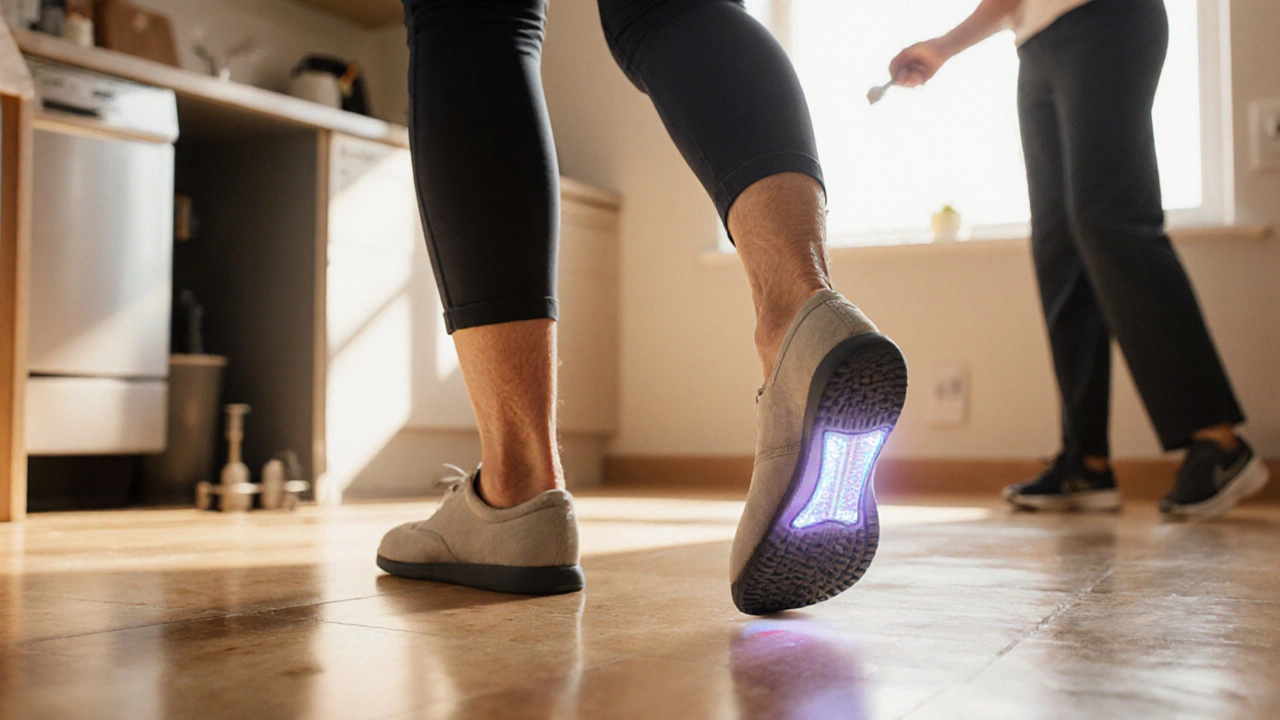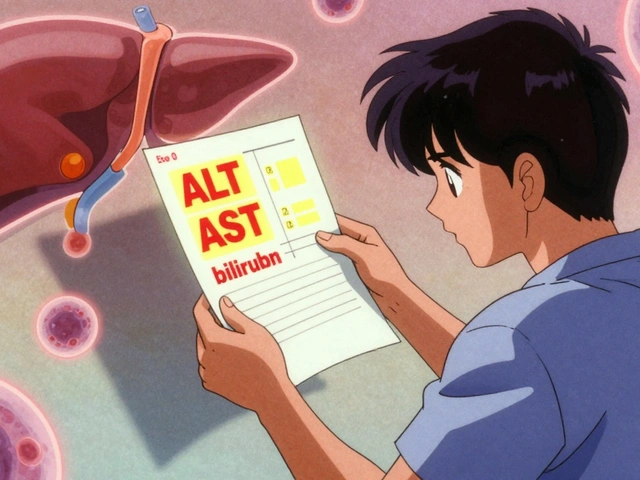
DPN Symptom Impact Calculator
This tool helps you understand how DPN symptoms may affect your daily activities and suggests management approaches.
Your DPN Impact Summary
Pain Score: 3
Balance Risk: 2
Foot Sensation: 4
Impact Level: Moderate
Recommended Actions:
Symptoms That May Impact Your Life
Pain & Discomfort
Burning or stabbing sensations affecting sleep and relaxation.
Balance Issues
Increased fall risk due to loss of foot sensation.
Foot Care
Numbness hiding injuries leading to ulcers or infections.
When a person lives with Diabetic Peripheral Neuropathy a nerve‑damage condition linked to long‑term diabetes, the simplest daily tasks can feel like hurdles.
Key Takeaways
- DPN stems from high blood sugar harming peripheral nerves, especially in the feet and hands.
- Pain, numbness, and balance issues can limit work, recreation, and self‑care.
- Effective management blends glucose control, medication, physical therapy, and proper footwear.
- Regular screening catches problems early, reducing the risk of ulcers and infections.
- Emotional support and lifestyle tweaks improve overall quality of life.
What Is Diabetic Peripheral Neuropathy?
In Diabetes Mellitus a chronic condition where the body cannot properly regulate blood glucose, excess sugar circulates for years and eventually damages the Peripheral Nerves the network of nerves that transmit signals to and from the limbs. This damage slows signal transmission, causing a mix of tingling, burning, or complete loss of sensation. The most common pattern is a “stocking‑glove” distribution, starting at the toes and moving upward.
How DPN Disrupts Daily Life
Imagine trying to button a shirt when your fingertips feel numb, or walking across a kitchen floor that feels like a foreign surface. Those moments are everyday reality for many people with DPN.
- Pain and Discomfort: Burning or stabbing sensations can flare up after a long day at work, making it hard to relax or sleep.
- Balance and Falls: Loss of proprioception in the feet reduces the ability to sense terrain, increasing fall risk, especially on stairs or wet surfaces.
- Foot Care Challenges: Numbness hides cuts or blisters that can develop into a Foot Ulcer a sore that fails to heal due to poor circulation and sensation. Untreated, ulcers can lead to infection or even amputation.
- Work Limitations: Jobs that require standing, manual dexterity, or precise foot control (e.g., chefs, cashiers, construction workers) become harder, sometimes forcing a career change.
- Social and Emotional Impact: Ongoing pain and mobility limits often lead to isolation, anxiety, or depression, dragging down overall Quality of Life a person's perceived well‑being across health, comfort, and happiness.

Managing Symptoms: A Multifaceted Approach
There’s no single magic pill, but combining several strategies can bring noticeable relief.
Medication and Pain Management
First‑line drugs include anticonvulsants like gabapentin and pregabalin, which calm overactive nerve signals. Tricyclic antidepressants (e.g., amitriptyline) also help some patients. While these medications can reduce pain, they may cause drowsiness, so a physician‑guided titration is essential.
Physical Therapy and Exercise
Targeted exercises improve muscle strength, balance, and circulation. A Physical Therapist a health professional specialized in movement rehabilitation can design a routine that includes ankle pumps, toe curls, and gentle yoga. Regular activity also boosts insulin sensitivity, indirectly aiding nerve health.
Footwear and Orthotics
Custom‑fit shoes with soft insoles reduce pressure points. Metatarsal pads spread load across the forefoot, preventing new ulcers. Many clinics offer a Neuropathy Screening a systematic assessment for early signs of nerve damage that includes foot‑wear evaluation.
Glycemic Control
Consistently keeping blood sugar within target ranges (Glycemic Control the management of blood glucose levels through diet, medication, and lifestyle) slows further nerve damage. Studies from 2023‑2024 show that a 1% reduction in HbA1c can lower the progression rate of neuropathy by roughly 30%.
Prevention and Early Detection
Detecting DPN early is the most effective way to keep it from taking over daily life.
- Annual Exams: During a diabetes check‑up, doctors should perform a simple monofilament test to assess foot sensation.
- Self‑Check Routine: Patients can feel each toe and foot for differences in temperature or texture. Any new numbness warrants a prompt call to the care team.
- Blood Sugar Monitoring: Continuous glucose monitors (CGMs) provide real‑time data, allowing quicker adjustments and better long‑term control.
- Weight Management: Maintaining a healthy weight reduces stress on the feet and improves insulin response.
Support Resources and Lifestyle Tweaks
Beyond medical treatment, community and personal habits play a big role.
- Support Groups: Local diabetes associations often host meetings where members share coping tips for neuropathy‑related challenges.
- Nutrition: Diets rich in omega‑3 fatty acids, antioxidants, and B‑vitamins support nerve health. Incorporating fatty fish, nuts, leafy greens, and whole grains can make a difference.
- Stress Reduction: Chronic stress spikes cortisol, worsening blood sugar control. Practices like meditation or short daily walks help keep stress in check.
- Technology Aids: Vibration‑feedback insoles alert wearers when pressure builds up, prompting a shift in stance before an ulcer forms.

Management Options Comparison
| Strategy | Primary Benefit | Main Drawback | Typical Cost (USD) |
|---|---|---|---|
| Medication (gabapentin, pregabalin) | Pain reduction within weeks | Potential drowsiness, dizziness | $30‑$120 per month |
| Physical Therapy | Improved balance and circulation | Requires regular appointments | $70‑$150 per session |
| Custom Footwear/Orthotics | Prevents pressure sores and ulcers | Initial fitting cost | $150‑$300 (one‑time) |
| Lifestyle (diet, exercise, CGM) | Slows disease progression | Self‑discipline needed | $0‑$200 per month (varies) |
Real‑World Example: Jane’s Journey
Jane, a 58‑year‑old accountant from Halifax, noticed tingling in her toes after ten years of type2 diabetes. A quick monofilament test at her clinic confirmed early DPN. She started low‑dose gabapentin, switched to shoes with custom insoles, and began a thrice‑weekly walking program. Within three months, her pain scores dropped from 7/10 to 3/10, and she avoided a foot ulcer that previously plagued her friends. Jane’s story underscores how early detection and a blended plan can keep DPN from dictating daily life.
Next Steps for Readers
- Schedule a neuropathy screening if you haven’t had one in the past year.
- Track your blood sugar daily; aim for the target range your doctor set.
- Discuss pain‑relief options with your healthcare provider, noting any side‑effects you’re concerned about.
- Invest in proper footwear-consult a podiatrist or orthotist.
- Join a local diabetes support group to share tips and stay motivated.
Remember, diabetic peripheral neuropathy doesn’t have to steal your independence. With the right mix of medical care, daily habits, and community help, you can reclaim control over your routine.
Frequently Asked Questions
Can DPN be reversed?
While existing nerve damage is usually permanent, strict glycemic control, early treatment, and lifestyle changes can halt further loss and sometimes improve mild symptoms.
How often should I check my feet for ulcers?
Daily visual inspection is ideal. If you have reduced sensation, enlist a family member to help and schedule a professional podiatry visit at least every six months.
Are over‑the‑counter creams effective for DPN pain?
Topical lidocaine or capsaicin can provide modest relief for localized pain, but they rarely replace prescription medications for widespread symptoms.
What role does exercise play in managing DPN?
Regular low‑impact activities-walking, swimming, cycling-improve circulation, lower blood glucose, and boost nerve health. Start slowly and increase duration as tolerated.
Should I stop wearing high‑heeled shoes?
High heels increase pressure on the forefoot and can worsen ulcers. Opt for low‑profile, supportive shoes with a wide toe box whenever possible.





11 Comments
I have seen countless patients struggle with the silent thief called DPN and it makes my heart ache because we all deserve to walk without fear and I cannot stand by while people ignore these warning signs and let their lives be dictated by unmanaged pain and numbness this is not just a medical issue it is a moral imperative to educate and empower every individual to take control of their glucose levels and seek proper footwear and therapy because our society thrives when we support the vulnerable and I feel a deep responsibility to shout out the importance of daily foot inspections and regular screenings even though some may think it is overly cautious I believe that caution saves limbs and preserves dignity
Thank you for sharing this comprehensive guide; it really shines a light on the daily hurdles faced by those with neuropathy, and I think the step‑by‑step recommendations are incredibly useful, especially the emphasis on regular foot checks and supportive footwear, which can make a huge difference in preventing ulcers; I also appreciate the inclusion of low‑impact exercise ideas, as staying active is often the hardest part for many; keep up the great work in spreading awareness!
First, let me point out that the article conflates glycemic control with neuropathy reversal, which is a scientifically inaccurate statement; second, the claim that a 1% HbA1c reduction lowers progression by ~30% lacks citation and oversimplifies complex pathophysiology; third, the list of medications omits duloxetine, an FDA‑approved option for DPN pain, thereby presenting an incomplete therapeutic landscape; fourth, suggesting “custom‑fit shoes” without specifying material standards or pressure mapping data is vague; fifth, the advice to “engage in low‑impact exercises” should be qualified with contraindications for patients with severe autonomic neuropathy; sixth, the warning about high‑heeled shoes fails to acknowledge that certain orthotic designs can mitigate forefoot pressure; seventh, the table of costs does not account for insurance variations or regional price differences; eighth, the recommendation to check feet daily assumes patients have sufficient dexterity, ignoring those with severe hand neuropathy; ninth, the article’s tone is overly optimistic, bordering on anecdotal, which may give false hope; tenth, the mention of “vibration‑feedback insoles” lacks discussion of battery life and data privacy concerns; eleventh, the FAQ does not address the role of emerging disease‑modifying agents currently in clinical trials; twelfth, the statement that “stress reduction helps blood sugar” should be tied to specific cortisol pathways; thirteenth, the suggestion to join support groups is sound but should include online options for remote patients; fourteenth, the dietary advice could benefit from referencing the ADA’s recommended macronutrient distribution; fifteenth, the overall structure would be stronger if it separated prevention from management more distinctly; in summary, while the article is a decent primer, it requires substantial revisions for accuracy, completeness, and nuance.
The practical tips are solid, especially the reminder about orthotics, but I’d caution readers that not every custom insole is created equal; a podiatrist’s assessment is essential to avoid off‑loading the wrong area, which could inadvertently cause new pressure points.
From a systems‑engineering perspective, the integration of CGM data streams with predictive analytics could revolutionize DPN management by flagging glycemic excursions that correlate with neuropathic flare‑ups, thereby enabling preemptive pharmacologic adjustments; however, the current clinical workflow lacks the interoperability standards to support such data exchange, leading to siloed information and suboptimal therapeutic outcomes.
While the previous comment dives deep into techno‑jargon, it forgets the human element – patients need clear, actionable advice now, not a future‑tech manifesto that may never materialize; simplicity and immediacy should guide our recommendations.
To add to the earlier technical discussion, evidence from recent meta‑analyses indicates that combining gabapentin with a structured aerobic regimen yields a statistically significant reduction in pain scores (p<0.05) compared to monotherapy; this synergistic effect underscores the importance of multidisciplinary protocols.
Excellent summary; the emphasis on daily foot inspection aligns with best practice guidelines and should be highlighted in patient education materials.
Great, another checklist for people who already know everything.
I appreciate the thoroughness of the article; its balanced presentation of pharmacologic and non‑pharmacologic strategies provides a useful roadmap for clinicians and patients alike.
Reading this felt like a warm hug for my nerves 😊 keep sharing these lifelines!